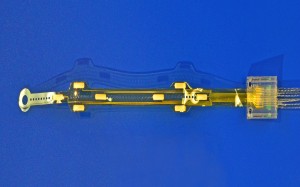Dr. Andrew Maynard’s May 20, 2014 article (Small Packages; A new case study on the health risks of nanotech doesn’t tell the whole story) for Slate magazine does much to calm any fears there might be in the wake of a recent case study about the consequences of handling nickel nanoparticles in the workplace,
… The report describes a chemist who developed symptoms that included throat irritation, nasal congestion, facial flushing, and skin reactions to jewelry containing nickel, after starting to work with a powder consisting of nanometer-sized nickel particles. According to the report’s lead author, this is “case one in our modern economy” of exposure to a product of nanotechnology leading to an individual becoming ill.
…
… And this is why the case of the nickel nanoparticles above needs to be approached with some caution. Many people have an allergic skin reaction to nickel, and research has shown that inhaling nickel particles can cause people to become sensitized to the metal. It’s also well known that fine powders will become airborne more easily than coarse ones when they’re handled, and that the finer the powder you inhale, the more potent it is in your lungs. So it shouldn’t come as a surprise that handling nickel nanopowder in an open lab without exposure controls is not a great idea. In other words, the reported incident was more a case of bad exposure management than nanoparticle risk.
That said, the case does highlight the level of respect with which any new or unusual material should be treated. …
Reinforcing Andrew’s comments about nickel sensitivities, there’s a recent report about smartphones and metal sensitivities. From a May 21, 2014 article by Sarah Knapton for The Telegraph (UK), Note: A link has been removed,
If you have ever noticed swelling, redness, itching or blistering near your cheekbones, ears, jaw or hands, you may be allergic to your phone.
A new study suggests the nickel, chromium and cobalt found in common phones made by BlackBerry, Samsung and LG among others, can cause skin irritations.
Danish and US researchers found at least 37 incidents since 2000 where contact dermatitis was caused by mobile phones.
Here are links to and citations for the nickel case study and to the smartphone paper,
Occupational handling of nickel nanoparticles: A case report by W. Shane Journeay, MD, and Rose H. Goldman, MD. American Journal of Industrial Medicine Article first published online: 8 MAY 2014 DOI: 10.1002/ajim.22344
Mobile Phone Dermatitis in Children and Adults: A Review of the Literature by Clare Richardson, Carsten R. Hamann, Dathan Hamann, and Jacob P. Thyssen. Pediatric Allergy, Immunology, and Pulmonology. Online Ahead of Print: March 5, 2014. doi:10.1089/ped.2013.0308.
The nickel paper is behind a paywall and the smartphone paper is open access.
One comment, the smartphone literature search yielded a small sample, on the other hand, if there isn’t category for the problem, it might not get into reports and be studied.
Getting back to Andrew’s article, it is illuminating and frustratingly opaque (perhaps there was an editing issue?),
Over a couple of days in London last summer, I found myself mulling over a very similar question with a small group of colleagues. We were a pretty eclectic group—engineers, designers, toxicologists, business leaders, academics, policy wonks—but we had one thing in common: We wanted get a better handle on how dangerous realistic products of nanotechnology might be, and how these dangers might be avoided.
… Our approach was to imagine products based on engineered nanomaterials that were technologically feasible and would also have a reasonable chance of surviving a cut-throat economy—products like active food packaging labels that indicated the presence of contaminants; helium-filled balloons with solar cell skins; and materials templated from viruses to generate hydrogen and oxygen from water. We then tried to imagine how these plausible products could potentially release dangerous materials into the environment.
To our surprise, we struggled to come up with scenarios that scared us.
It sounds like this session was organized as a think tank. It would have been nice to know who organized it, who were their invitees, and what was their expertise. On that note, there is this about Andrew at the end of the Slate article,
Andrew Maynard is a leading expert on the responsible development and use of emerging technologies and is the director of the U-M [University of Michigan] Risk Science Center.
Having stumbled across Andrew many times over the years within the ‘nano blogosphere’ and having him kindly answer my amateurish questions about reading research, I feel confidence when reading his opinion pieces that he is well informed and has carefully considered not only questions I might ask but others as well.
While I might like to know more about that 2013 think tank session in London (UK), this section towards the end of the piece suggests that Andrew has not, in an excess of enthusiasm, thrown in his lot with some hype happy group,
… the case [nickel inhalation] does highlight the level of respect with which any new or unusual material should be treated. This was also one of the conclusions from those two days in London. Just because the risks of many nanotechnology products seem relatively small, doesn’t mean that we can afford to be complacent. There’s still the possibility that someone will create a particularly dangerous new material, or will use a material that seems safe in a dangerous way. As a society we need to be vigilant when it comes to advanced materials, whether they are branded with the nano insignia or not.
As for Knapton article and smartphone research, I haven’t come to any particular conclusions but I am going to keep an eye out for evidence, anecdotal or otherwise. A friend of mine, who sometimes suffers from skin sensitivities, just switched over to her first Blackberry.
